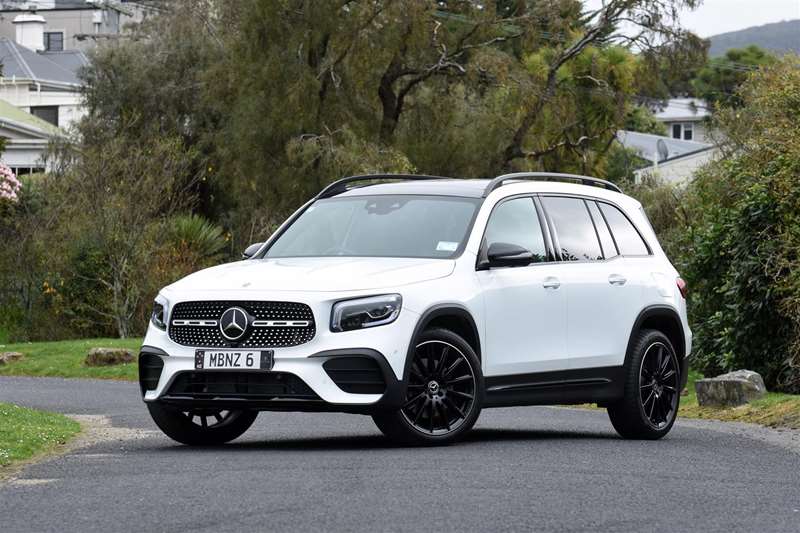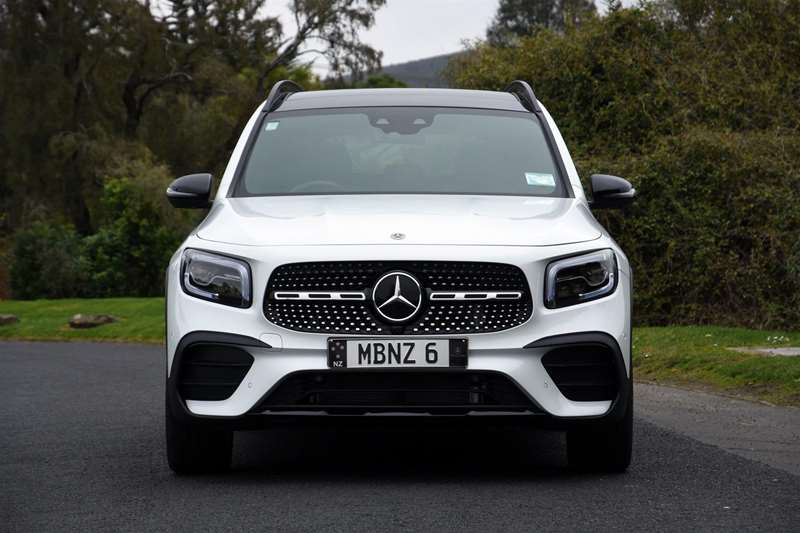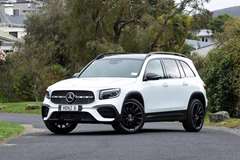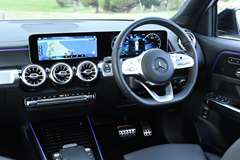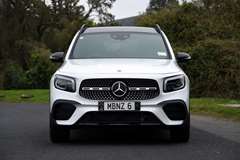David Thomson and friends have been trying the new Mercedes GLB for size.
What’s new?
Filling the gaps between existing models in a sports utility range is something car-makers are wont to do these days. Mercedes-Benz is in on the game, with the GLB recently introduced to sit between its existing GLA and GLC models.
Add in the GLE, which sits above the GLC, and factor in that all three are offered in coupe as well as conventional guise, and the extent of Mercedes’ current SUV range is impressive. And that’s without counting the all-electric EQC, tested on these pages a few weeks back, or Mercedes’ ultimate off-roader, the G-Class.
In Mercedes-speak, GL means SUV, and the letter that follows GL links to the equivalent conventional car model. So GLB is the SUV equivalent of the B-Class, a compact Mercedes hatchback that first appeared in 2005, and was launched in its current third-generation guise in 2018.
This new GLB is the first SUV counterpart to the B-Class. The pair share underlying platform elements, but the GLB has a substantially extended wheelbase, and is longer, wider and taller, too. That extra length enables Mercedes to deliver a 5+2 seating format, with a pair of child-friendly seats as a pop-up third row of seating.
New Zealand has three models available, opening with the front-wheel-drive GLB 200 120kW 1.3-litre turbo at $78,900, and topping out with the all-wheel-drive AMG GLB 35 225kW 2.0-litre turbo at $104,900.
This test is of the mid-range offering, the all-wheel-drive GLB 250 165kW 2.0-litre turbo, which comes in at $92,900.
What’s it like to look at?
Mercedes has looked to the head of its SUV range for design inspiration, with the GLB resembling a shrunken GLS far more than a GLA or GLC.
So assertive looksare the order of the day, which isn’t a bad approach for a vehicle that might otherwise be pigeonholed as small in proportion to its actual size.
The photos that accompany this test should illustrate this point. That upright, squared-off vehicle you can see may sit towards the bottom of the Mercedes SUV range dimensionally, but size-wise it is still in the ballpark of a Volvo XC60 or Audi Q3, a bit bigger than the current Mazda CX-5 and has a superior wheelbase to the VW Tiguan Allspace.
The test car picked up several optional visual enhancements, including metallic-finish white paint ($1490), classy 20-inch AMG alloy wheels shod with 235/40 tyres ($1990) in place of the standard 19-inch rims and a $1990 sports package, which included additional AMG styling enhancements, rear privacy glass and black roof rails.
What’s it like inside?
Providing seven seats in its second-smallest SUV is a bold call by Mercedes, but accepting that the rear pair are for children and there is minimal boot room when they are deployed, it’s a call that makes sense.
The keys to packaging success are twofold:firstly, the relatively long wheelbase and tall cabin of the GLB; and secondly, having a middle row of seats that adjust for back angle and legroom to allow some juggling of space.
The individual rear seats are easily raised from the boot floor by way of manual pull-tag. When they are stowed, activating the power operated tailgate gives access to a 500-litre boot cavity, along with an extra area under the floor. When the middle row of seats are folded down this cargo area trebles.
Three average-sized adults occupied the middle row seats for a portion of this test. With that row set as far back as possible there was plenty of legroom and ample headroom, although the centre seating position is a little perched and not especially supportive. Deep windows and a panorama sunroof ensure the middle row is light and airy. Separate air vents, decent door bins and two USB-C plug-in points are provided in the back, too.
It was noted that the rear doors take quite a slam to shut properly. This was especially so from the inside as the interior door handles are not optimally positioned for leverage, but was also an issue from the outside.
Up front the cabin is comfortable, although the power-adjusting seats could do with a bit more lateral support.With the test car including the $2490 AMG Exclusive pack, those seats were trimmed in colour contrasted leather and fitted with seat heating and chilling functions.
The dash and general layout echoes other medium-compact members of the Mercedes range. The double widescreen display with full digital instrumentation and associated MBUX command system is fitted, including the‘‘Hi Mercedes’’ voice control set-up.
A trio of turbine-like vents across the centre of the dash and matching single vents either side of the fascia are the other prominent design element. There’s a neat little trick with the interior LED lighting associated with the vents too — turn the heating up a notch or two on either side of the car, and the relevant vents momentarily glow red.
The lower surfaces in the cabin are OK, but the upper surfaces are nicely finished, with plenty of contrast surfacing. Themultifunction steering wheel and various knobs and buttons also have a premium feel.
What comes as standard?
Much of the GLB 250 4MATIC’s standard equipment has already been mentioned. Other creature comfort and convenience features include dual-zone climate control, satellite navigation, remote engine starting, keyless entry and go, customisable LED strip lighting, a premium audio system, wireless charging, smartphone integration and Mercedes’ own online connectivity system.
The standard GLB safety specification includes active lane keeping assistance, active braking assistance, pre-safe assist and attention monitoring. The $1990 Driver Assistance Package included on the test car added active cruise control with route-based speed adaptation, lane-change assist and extended automatic restart for traffic.
This package, along with all the other extras detailed earlier, lifted the price of the test car from $92,900 to $104,040.
What’s it like to drive?
The GLB features independent suspension all round. With adaptive damping included inits sports pack, the test car was particularly well balanced dynamically.
Being quite tall, and set up to prioritise comfort over sharp responses, the GLB 250 displays some bodyroll when cornering at anything beyond modest speeds. The adaptive damping contains both the roll and an associated bias towards understeer pretty well, and ensures a fair degree of agility operating in the car’s sportiest drive mode.
While this — along with steering that is nicely weighted, but light on feel — means the GLB (except, perhaps, in full AMG spec) isn’t an especially rewarding machine on winding tarmac, it exhibits ample dynamic prowess in other situations.
A particular highlight on test was the car’s sure-footed and utterly fuss-free manner on gravel roads rendered slippery by recent rain. There was none of the floaty tendency that some premium SUVs exhibit on dirt and gravel, the automated 4WD system was quietly efficient and stability systems not too intrusive.
Even on poor surfaces (tarmac or otherwise) ride quality was very good, albeit with sharper surface imperfections sometimes making their presence felt.
Around-town driving was as easy as it should be in a decent midsized SUV, helped by good visibility in most directions, with sensors and cameras picking up the slack. The highway haul was adroitly handled too, albeit with the handling limitations described above a factor on slower-speed bends.
Mechanical refinement is very good and performance fine at light to medium speeds, but there’s far more fun to be had when pushing the 2.0-litre turbo engine to unleash its full 165kW and 350Nm. Avery respectable 6.9-second time for the 0-100kmh dash is there for the taking in full sport mode, and that’s while leaving the GLB’s slick eight-speed automatic to its own devices rather than indulging in paddle-shift power play.
Economy is rated at 7.7l/100km on the standard cycle haul, and while this was not matched on test, the 8.7l/100km result achieved was pleasing given the nature of driving and passenger and cargo loads involved.
Verdict
In three generations of trying, Mercedes has struggled to make the B-Class hatchback a vehicle to remember. The GLB, in contrast, feels on the money first time up. Fine interior packaging certainly counts as its key strength, but it is also a pleasing vehicle to look at, and — in 250 4MATIC form — dynamically accomplished, too.
